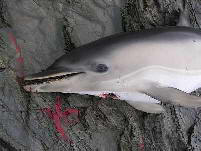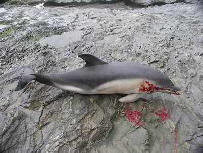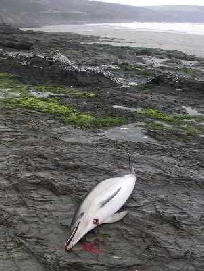EUROPEAN CETACEAN BYCATCH CAMPAIGN
"Man is but a strand in the complex web of life"
"Man is but a strand in the complex web of life"
Dolphin slaughter begins again
Cornish Wildlife Trust
16th January 2006
A young, female Common dolphin is just one of the 17 latest victims to die in fishing nets around Cornwall over the last few days. Only 1.5m long, the young dolphin was found on the Roseland Peninsular, while many others, males and females of all ages, were recorded along the south coast.
Every year, the Cornwall Wildlife Trust’s Marine Strandings Network carries out the grim task of recording, examining and measuring the carcasses. Maddi Precious, who covers the special 24-
The volunteer who attended the young female dolphin said, “It’s much worse when you find a small one like this. At first glance, she looked so perfect. She had died so recently that the seagulls hadn’t attacked her and her eyes were still bright. Apart from a few scratches, and a strange, deep hole under chin, her skin was smooth and perfect, except for the obvious fishing net marks around her beak and on her flippers. The only good thing to come out this was that because she was so fresh, we were able to take her, and two others, for post mortem examinations. I don’t doubt for a moment that they will confirm that these dolphins died in fishing nets. We see it year, after year, after year.”
Joana Doyle, Marine Conservation Officer for Cornwall Wildlife Trust commented, “Yet again, the slaughter of dolphins has begun and it is apparent that the ban on pair trawlers fishing within the 12 mile shore limit is not working. After all, as we always said, dolphins feeding outside the area are just as likely to be caught, as they don’t know where the limit is! And from the evidence we have collected over many, many years, we have proven that it’s not just the bass pair trawlers that are to blame. Inshore gillnet fishing does kill dolphins and most of those killed over the last few days were found around St Austell Bay, where there is an inshore gillnet fishery. We have also recently had a rare Bottlenose dolphin – the one everyone recognises and loves – that showed evidence of being bycaught in this way.
Joana continued, “Right now, the UK Government is being criticised by the European Commission for not adequately monitoring how effectively they are protecting our populations of cetaceans -
Top
Young female Common Dolphin
Photographs
taken by Jeff Loveridge,
Marine Strandings Network volunteer.
Photographs
taken by Jeff Loveridge,
Marine Strandings Network volunteer.
Young female Common Dolphin
Photographs
taken by Jeff Loveridge,
Marine Strandings Network volunteer.


